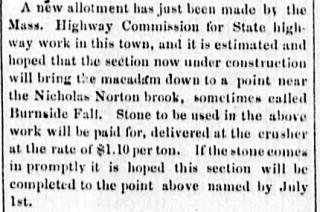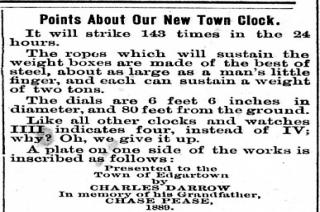The towns of Edgartown and Tisbury were born as part of New York Colony, fraternal twins that on Thursday this week celebrated their sesquarcentennial anniversaries.
Edgartown
1920
July 8, 1920
To the martial music of her own brass band, Edgartown staged a parade in celebration of the Fourth and in honor of her veterans of the World war, which must have convinced these forty-five youths and men that they still stand ace-high in the estimation of their fellow townsmen. For Edgartown does not forget and she proved that memorable fact in a memorable fashion.
1901
June 6, 1901
A new allotment has just been made by the Mass. Highway Commission for State highway work in this town, and it is estimated and hoped that the section now under construction will bring the macadam down to a point near the Nicholas Norton brook, sometimes called Burnside Fall. Stone to be used in the above work will be paid for, delivered at the crusher at the rate of $1.10 per ton. If the stone comes in promptly it is hoped this section will be completed to the point above named by July 1st.
1900
August 9, 1900
Edgartown is in the swim with other resorts. The horseless carriage is here. The first to appear is the locomobile of Mr. Elmer J. Bliss, of the Regal Shoe, who brought this vehicle down from Boston Saturday night. Mr. Bliss had his locomobile out on Sunday, and it worked very satisfactorily on our streets.
1890
November 21, 1890
We take pleasure in printing below a few particulars regarding the new hotel to be erected on Starbuck’s Bluff, Edgartown, the specifications calling for the building’s completion by May 15, 1891. Mr. Cummings, the well-known Troy (N.Y.) architect, drew the plans, and these and the specifications call for a structure which will be attractive, of first-class appointments, and built in the most thorough manner.
1889
November 8, 1889
It will strike 143 times in the 24 hours.
The ropes which will sustain the weight boxes are made of the best steel, about as large as a man’s little finger, and each can sustain a weight of two tons.
The dials are 6 feet 6 inches in diameter, and 80 feet from the ground.
Like all other clocks and watches IIII indicates four, instead of IV; why? Oh, we give it up.
A plate on one side of the works is inscribed as follows:
Presented to the
March 22, 1889
Mr. Editor: As you have kindly consented to publish any communication from those interested in the public good and well-being of the community, I think a short review of the past, as well as our hope for the future, may be profitable.







